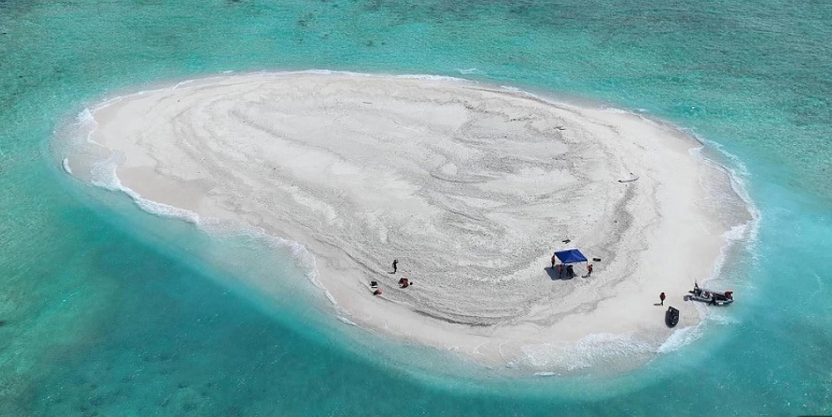China’s state-run Global Times reported that the China Coast Guard (CCG) took control of Sandy Cay in the West Philippine Sea. This area is part of the South China Sea that the Philippines claims under its exclusive economic zone (EEZ). The Chinese state broadcaster CCTV released images of four CCG officers with the Chinese flag on the sandbar, which it described as a declaration of sovereignty.
In response, the Philippine National Task Force on the West Philippine Sea (NTF-WPS) quickly dismissed China’s claims. The Philippines’ maritime authorities confirmed the situation and nullified Beijing’s sovereignty assertions. Soon after, Philippine Coast Guard (PCG) and Navy personnel hoisted the Philippine flag on Sandy Cay, reaffirming the country’s rights to the area.
China’s Actions and International Law
According to the United Nations Convention on the Law of the Sea (UNCLOS), Sandy Cay is considered a rock permanently above water. This means it is entitled to a 12-nautical-mile territorial sea. Sandy Cay lies about two nautical miles from Pag-Asa Island, part of the Philippines’ Palawan province, and well within its territorial sea.
Sandy Cay is also located roughly 10 nautical miles from Subi Reef, a feature China has illegally occupied and turned into a military base. By controlling Sandy Cay, Beijing could strengthen its claims over Subi Reef and potentially expand its reach toward Pag-Asa Island, which houses Philippine military installations and a population of about 250 Filipinos.
China’s Expanding Presence in the West Philippine Sea
China’s interest in Sandy Cay dates back to 2017 when the Philippines began constructing shelters on the sandbar for Filipino fishermen. China objected, arguing that the status of the feature should remain unchanged in line with the non-binding Declaration on the Conduct of Parties in the South China Sea (DCOC) signed by ASEAN and China in 2002.
At the time, the Philippines was under President Rodrigo Duterte, who adopted a more conciliatory approach towards China. Duterte ordered the military to halt construction on Sandy Cay, which China interpreted as an opportunity to advance its territorial ambitions in the region.
This period also saw increased provocative actions from the CCG and the Chinese maritime militia. These forces created a de facto barrier around Sandy Cay, restricting Filipino fishing boats. In 2019, Chinese forces expanded their operations near Pag-Asa Island, a move that seemed to foreshadow future actions against Sandy Cay, reminiscent of the 2012 Scarborough Shoal standoff.
A Stronger Approach Under President Marcos
Under the leadership of President Ferdinand Marcos Jr., the Philippines has taken a more assertive stance on defending its sovereignty in the West Philippine Sea. In December 2023, the Philippine Coast Guard established a new outpost on Pag-Asa Island to monitor activity in the region more effectively. The Philippines has also expanded infrastructure on the island, improving both living conditions and its strategic capabilities.
The situation has become more complicated, however, as the Chinese Coast Guard and maritime militia continue their harassment. Despite the symbolic nature of China’s recent actions on Sandy Cay, it is part of a broader strategy of gradual territorial expansion, known as “salami slicing,” aimed at eventually controlling the entire West Philippine Sea.
The Philippines’ Path Forward
Although China has not yet fully taken control of Sandy Cay, the Philippines faces an ongoing challenge in securing its maritime rights. China’s occupation of features like the Second Thomas Shoal and Subi Reef has already threatened Philippine sovereignty. The Philippines must ensure a consistent military and civilian presence in vital areas like Sandy Cay, Pag-Asa Island, and the surrounding waters to deter further Chinese encroachment.
Furthermore, the Philippines should continue to partner with other nations for joint patrols in the region to maintain a balance of power. Building stronger international partnerships and enhancing civil society cooperation will also be key in countering China’s influence, especially as Beijing increasingly seeks to manipulate the information space to foster dissent within the Philippines.
The Philippines’ response to China’s actions in the West Philippine Sea will be crucial in determining the future of the region. Ensuring a robust presence and maintaining diplomatic pressure on China are essential steps in safeguarding the country’s sovereignty and maritime rights.

